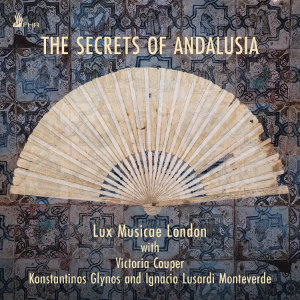
The Secrets of Andalusia
Contents listed after review
Lux Musicae London
rec. 2023, Church of the Ascension, Plumstead, London
First Hand Records FHR 157 [71]
The secrets of Andalusia, this wonderful region of Southern Spain, lie in its remote mountains and still, sometimes remote villages – but the music has its own mysteries and much local colour. This programme, pieces from the 15th to the 18th centuries, includes works by some little-known figures, for example singer and guitarist Francisco Guerau. I had to chuckle to think that this exotic music was recorded on three cold February days in a church in dear old Plumstead, which has the most suitable acoustic.
Andalusia may bring to mind flamenco, which runs as a significant thread through this disc. (I remember being advised in Seville to avoid the touristy performances. Instead, I was told to take a certain side road and visit an estudio where one could see flamenco taught and demonstrated. I was quite smitten.) Another thread is to show how certain songs can sound different depending on the style: Sephardic, Baroque, flamenco, and even modern as in the two versions of A la una nací yo. This varied, if arguably slightly unfocused, programme also includes Spanish instrumental baroque pieces.
Lux Musicae London are well able to create the soundscape written about in the booklet. There are five regular singers, recorders, a baroque harp and baroque guitar, a viola da gamba. Guests play flamenco guitar and kanun (qanun), a sort of Arabic zither. I will sample the programme to help gauge what the performers are aiming to achieve with this recording.
Traditional music from Andalusia is represented, for example, by the lullaby Nani Nani. Soprano Roberta Diamond remembers it from her childhood, and sings here unaccompanied, with much sensitivity. She also set a 12th-century Arabic text, translated as Tears have betrayed my secrets in a valley, a reminder of the Arabic influence in Southern Spain.
This overlaps with the flamenco tradition. Guitarist Ignacio Lusardi Monteverde arranged Yo m’en amori d’un for soprano, kanun, baroque guitar and flamenco guitar. He also plays his own composition Pueblo blanco for flamenco guitar. The renaissance song Dindirín, dindirín (which the King’s Singers recorded in the 1980s) suddenly bursts incongruously into a flamenco frolic in its middle section before returning to base, as it were.
Spanish baroque is represented by delightful pieces like Juan Vasques’s song translated as With what shall I wash my face, and by instrumental works like Guerau’s Passacaglia played on baroque guitar and Fonesca’s Españoletas played on the harp. This is the clear European, especially Italian, influence on Spain.
We are offered two examples of glossadas or divisions with ornamentation probably typical of the time. Lassus’s famous Susanne un jour was elaborated by Hernando de Cabezón (son of the great Antonio), with the help of Roberta Diamond’s versatility. There is a piece performed on guitar and viola da gamba from the 1553 publication Trattado (the art of ornamentation) by Diego Ortiz.
The singers are perfect for this repertoire, especially the women. It is a joy to hear their classic Spanish, sometimes dark, tone quality, their immaculate diction and intonation. The instrumental work is neat and full of character. The excellent booklet has a revealing essay of much interest, colour photos of the instruments and performers, with their biographies. Full texts are lucidly translated and, if your geography is a bit dodgy, there is part of an ancient map of Andalusia and Granada on the central pages.
My favourite track? Like the performers, as they seem to imply in the booklet, the haunting quality of the late 15th-century song Tres morillas m’enamoran en Jaén about three enchanting Moorish girls sums up the delightful hour spent in the company of this disc.
Gary Higginson
Buying this recording via a link below generates revenue for MWI, which helps the site remain free


Contents:
1. Traditional
Durme, durme
2. Pierre-Francisque Caroubel (1556-c.1611)
Spagnolette
3. Luis Ruyiz de Ribayaz y Fonesca (1626-after 1677)
Españoletas
4. Anonymous (15th century)
Tres morillas m’enamoran en Jaén
5. Traditional
A la una yo nací
6. Traditional (arr. Ignacio Lusardi Monteverde)
Yo m’enamori d’un aire
7. Orlande de Lassus (c.1530-1594) set by Hernando de Cabezón (1541-1602)
Glossada sobre Susana un jur
8. Traditional
A la una nací yo
9. Francisco Guerau (1649-1722)
Passacaglia
10. José Marín (c.1619-1699)
Ojos, pues me desdeñais
11. Anonymous (15th century)
Dindirín, dindirín
12. Traditional (arr. Roberta Diamond)
Nani Nani
13. Juan Vasquez (c.1500-1560)
Con qué la lavaré la tez
14. Diego Ortiz (c.1510-1576)
Trattado de Glosas, Recercada segunda
15. Traditional (arr. Monterverde)
Samai Andalus
16. Roberta Diamond (b.1989)
Tears have betrayed my secrets in a valley
17. Bartolomé de Selma y Salaverde (c.1580-1640)
Canzoni fantasie et correnti da suonar, Vestiva I colli
18. Ignacio Lusardi Monteverde (b.1983)
Pueblo blanco (2018)
19. Anonymous (15th century)
Qué me quréis, caballero?
20. Juan Bonnet de Parades (?after 1718)
Cuándo, cuándo podré lograrte
21. Juan Aranes (?-c.1649)
Un sarao de la chacona ‘A la vide bona’ (1624)
Performers
Lux Musicae London:
Aileen Henry (baroque harp)
Harry Buckoke (viola da gamba)
Sophie Creaner (recorder)
Roberta Diamond (soprano)
Daniel Thomson (tenor)
Mirjam-Luise Münzel (recorder)
Toby Carr (baroque guitar and lute)
Guests:
Victoria Couper (soprano)
Konstantinos Glynos (kanun)
Ignacio Lusardi Monteverde (flamenco guitar, oud)

















